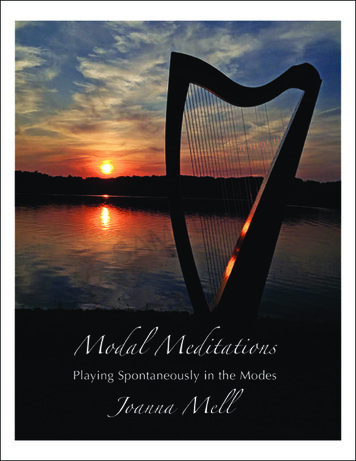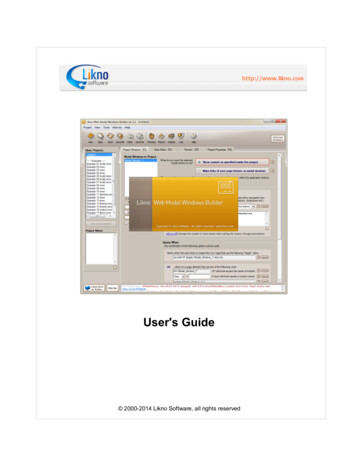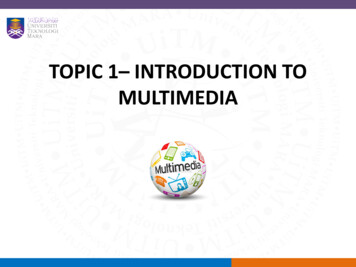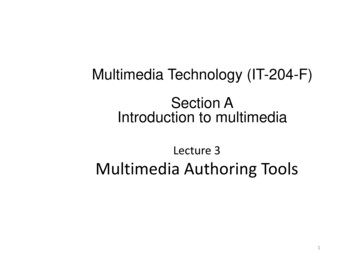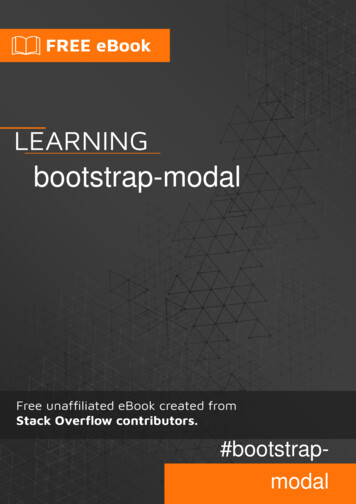
Transcription
Chapter 5Cross Modal MultimediaRetrieval77
785.1IntroductionOver the last decade there has been a massive explosion of multimedia con-tent on the web. This explosion has not been matched by an equivalent increase inthe sophistication of multimedia content modeling technology. Today, the prevailing tools for searching multimedia repositories are still uni-modal in nature. Textrepositories are searched with text queries, image databases with image queries,and so forth. To address this problem, the academic community has devoted itselfto the design of models that can account for multi-modal data, i.e. data with multiple content modalities. Recently, there has been a surge of interest in multi-modalmodeling, representation, and retrieval [106, 148, 132, 138, 28, 60, 31]. Multi-modalretrieval relies on queries combining multiple content modalities (e.g. the imagesand sound of a music video-clip) to retrieve database entries with the same combination of modalities (e.g. other music video-clips). These efforts have, in part, beenspurred by a variety of large-scale research and evaluation experiments, such asTRECVID [132] and ImageCLEF [106, 148], involving datasets that span multipledata modalities. However, much of this work has focused on the straightforwardextension of methods shown successful in the uni-modal scenario. Typically, thedifferent modalities are fused into a representation that does not allow individualaccess to any of them, e.g. some form of dimensionality reduction of a large featurevector that concatenates measurements from images and text. Classical uni-modaltechniques are then applied to the low-dimensional representation. This limits theapplicability of the resulting multimedia models and retrieval systems.An important requirement for further progress in these areas is the development of sophisticated joint models for multiple content modalities. In this chapter,we consider a richer interaction paradigm, which is denoted cross-modal retrieval.The goal is to build multi-modal content models that enable interactivity withcontent across modalities. Such models can then be used to design cross-modalretrieval systems, where queries from one modality (e.g. video) can be matchedto database entries from another (e.g., the best accompanying audio-track). Thisform of retrieval can be seen as a generalization of current content labeling systems, where one dominant modality is augmented with simple information from
79another, which can be subsequently searched. Examples include keyword-basedimage [4, 97, 21] and song [151, 149, 89, 36] retrieval systems. One property ofcross-modal retrieval is that, by definition, it requires representations that generalize across content modalities. This implies the ability to establish cross-modallinks between the attributes (of different modalities) characteristic of each document, or document class. Detecting these links requires much deeper contentunderstanding than the classical matching of uni-modal attributes. For example,while an image retrieval system can retrieve images of roses by matching red blobs,and a text retrieval system can retrieve texts about roses by matching the “rose”word, a cross-modal retrieval system must abstract that the word “rose” matchesthe visual attribute “red blob”. This is much closer to what humans do thansimple color or word matching. Hence, cross-modal retrieval is a better contextthan uni-modal retrieval for the study of fundamental hypotheses on multimediamodeling.We exploit this property to study two hypotheses on the joint modelingof images and text. The first, denoted the correlation hypothesis, is that explicitmodeling of low-level correlations between the different modalities is of importancefor the success of the joint models. The second, denoted the abstraction hypothesis,is that the modeling benefits from semantic abstraction, i.e., the representation ofimages and text in terms of semantic (rather than low-level) descriptors. Thesehypotheses are partly motivated by previous evidence that correlation, e.g., correlation analysis on fMRI [55], and abstraction, e.g., hierarchical topic models fortext clustering [14] or semantic representations for image retrieval(see Chapter 3),improve performance on uni-modal retrieval tasks. Three joint image-text modelsthat exploit low-level correlation, denoted correlation matching, semantic abstraction, denoted semantic matching, and both, denoted semantic correlation matching, are introduced. Both semantic matching and semantic correlation matchingbuild upon the proposed semantic image representation (see Chapter 2).The hypotheses are tested by measuring the retrieval performance of thesemodels on two reciprocal cross-modal retrieval tasks: 1) the retrieval of text documents in response to a query image, and 2) the retrieval of images in response
80to a query text. These are basic cross-modal retrieval problems, central to manyapplications of practical interest, such as finding pictures that effectively illustratea given text (e.g., to illustrate a page of a story book), finding the texts that bestmatch a given picture (e.g., a set of vacation accounts about a given landmark),or searching using a combination of text and images. Model performance on thesetasks is evaluated with two datasets: TVGraz [66] and a novel dataset based onWikipedia’s featured articles. These experiments show independent benefits toboth correlation modeling and abstraction. In particular, best results are obtainedby a model that accounts for both low-level correlations — by performing a kernelcanonical correlation analysis (KCCA) [127, 163] — and semantic abstraction —by projecting images and texts into a common semantic space (see Chapter 2) designed with logistic regression. This suggests that the abstraction and correlationhypotheses are complementary, each improving the modeling in a different manner.Individually, the gains of abstraction are larger than those of correlation modeling.This chapter is organized as follows. Section 5.2 discusses previous work inmulti-modal and cross-modal multimedia modeling. Section 5.3 presents a mathematical formulation for cross-modal modeling and discusses the two fundamentalhypotheses analyzed in this work. Section 5.4 introduces the models underlyingcorrelation, semantic, and semantic correlation matching. Section 5.5 discussesthe experimental setup used to evaluate the hypotheses. Model validation andparameter tuning are detailed in Section 5.6. The hypotheses are finally tested inSection 5.7.5.2Previous WorkThe problems of image and text retrieval have been the subject of ex-tensive research in the fields of information retrieval, computer vision, and multimedia [28, 133, 132, 106, 93]. In all these areas, the emphasis has been onuni-modal approaches, where query and retrieved documents share a single modality [125, 124, 156, 28, 133]. For example, in [124], a query text and in [156], a queryimage is used to retrieve similar text documents and images, based on low-level
81text (e.g., words) and image (e.g., DCTs) representations, respectively. However,this is not effective for all problems. For example, the existence of a well knownsemantic gap, (see Chapter 1) between current image representations and thoseadopted by humans, severely limits the performance of uni-modal image retrievalsystems [133](see Chapter 3).In general, successful retrieval from large-scale image collections requiresthat the latter be augmented with text metadata provided by human annotators. These manual annotations are typically in the form of a few keywords, asmall caption, or a brief image description [106, 148, 132]. When this metadatais available, the retrieval operation tends to be uni-modal and ignore the images— the text metadata of the query image is simply matched to the text metadataavailable for images in the database. Because manual image labeling is laborintensive, recent research has addressed the problem of automatic image labeling1[21, 63, 41, 73, 96, 4]. As we saw in Chapter 2, rather than labeling images witha small set of most relevant semantic concepts, images can be represented as aweighted combination of all concepts in the vocabulary, by projecting them into asemantic space, where each dimension is a semantic concept. Semantic space wasused for uni-modal image retrieval in Chapter 3, which enabled retrieval of images using semantic similarity — by combining the semantic space with a suitablesimilarity function.In parallel, advances have been reported in the area of multi-modal retrievalsystems [106, 148, 132, 138, 28, 60, 31]. These are extensions of the classic unimodal systems, where a common retrieval system integrates information from various modalities. This can be done by fusing features from different modalities intoa single vector [171, 108, 37], or by learning different models for different modalities and fusing their predictions [168, 69]. One popular approach is to concatenatefeatures from different modalities into a common vector and rely on unsupervisedstructure discovery algorithms, such as latent semantic analysis (LSA), to findstatistical patterns that span the different modalities. A good overview of thesemethods is given in [37], which also discusses the combination of uni-modal and1Although not commonly perceived as being cross-modal, these systems support cross-modalretrieval, e.g., by returning images in response to explicit text queries.
82multi-modal retrieval systems. Multi-modal integration has also been applied toretrieval tasks including audio-visual content [99, 44]. In general, the inability toaccess each data modality individually (after the fusion of modalities) limits theapplicability of these systems to cross-modal retrieval.Recently, there has been progress towards multi-modal systems that do notsuffer from this limitation. These include retrieval methods for corpora of imagesand text [31], images and audio [178, 76], text and audio [131], or images, text,and audio [175, 178, 182, 181, 176]. One popular approach is to rely on graphbased manifold learning techniques [175, 178, 182, 181, 176]. These methods learna manifold from a matrix of distances between multi-modal objects. The multimodal distances are formulated as a function of the distances between individualmodalities, which allows to single out particular modalities or ignore missing ones.Retrieval then consists of finding the nearest document, on the manifold, to amultimedia query (which can be composed of any subset of modalities). The mainlimitation of methods in this class is the lack of out-of-sample generalization. Sincethere is no computationally efficient way to project the query into the manifold,queries are restricted to the training set used to learn the latter. Hence, all unseenqueries must be mapped to their nearest neighbors in this training set, defeatingthe purpose of manifold learning. An alternative solution is to learn correlationsbetween different modalities [76, 178, 164]. For example, [76] compares canonicalcorrelation analysis (CCA) and cross-modal factor analysis (CFA) in the contextof audio-image retrieval. Both CCA and CFA perform a joint dimensionality reduction that extracts highly correlated features in the two data modalities. Akernelized version of CCA was also proposed in [164] to extract translation invariant semantics of text documents written in multiple languages. It was later usedto model correlations between web images and corresponding captions, in [55].Despite these advances in multi-modal modeling, current approaches tendto rely on a limited textual representation, in the form of keywords, captions, orsmall text snippets. We refer to all of these as forms of light annotation. Thisis at odds with the ongoing explosion of multimedia content on the web, whereit is now possible to collect large sets of extensively annotated data. Examples
83Martin Luther King’s presence in Birmingham was not welcomed by all in theblack community. A black attorney was quoted in ”Time” magazine as saying,”The new administration should have been given a chance to confer with thevarious groups interested in change.” Black hotel owner A. G. Gaston stated, ”Iregret the absence of continued communication between white and Negro leadership in our city.” A white Jesuit priest assisting in desegregation negotiationsattested, ”These demonstrations are poorly timed and misdirected.” Protestorganizers knew they would meet with violence from the Birmingham PoliceDepartment but chose a confrontational approach to get the attention of thefederal government. Reverend Wyatt Tee Walker, one of the SCLC founders andthe executive director from 19601964, planned the tactics of the direct actionprotests, specifically targeting Bull Connor’s tendency to react to demonstrations with violence. ”My theory was that if we mounted a strong nonviolentmovement, the opposition would surely do something to attract the media, andin turn induce national sympathy and attention to the everyday segregatedcircumstance of a person living in the Deep South,” Walker said. He headed(a)the planning of what he called Project C, which stood for ”confrontation”.According to this historians Isserman and Kazin, the demands on the city authorities were straightforward: desegregate the economic life of Birmingham itsrestaurants, hotels, public toilets, and the unwritten policy of hiring blacks formenial jobs only Maurice Isserman and Michael Kazin, America Divided: TheCivil War of the 1960s, (Oxford, 2008), p.90. (.)Home - Courses - Brain and Cognitive Sciences - A Clinical Approach to the Human Brain 9.22J / HST.422J A Clinical Approach to the Human Brain Fall 2006Activity in the highlighted areas in the prefrontal cortex may affect the level ofdopamine in the mid-brain, in a finding that has implications for schizophrenia.(Image courtesy of the National Institutes of Mental Health.) Course HighlightsThis course features summaries of each class in the lecture notes section, as wellas an extensive set of readings. Course Description This course is designed toprovide an understanding of how the human brain works in health and disease, and is intended for both the Brain and Cognitive Sciences major and thenon-Brain and Cognitive Sciences major. Knowledge of how the human brainworks is important for all citizens, and the lessons to be learned have enormousimplications for public policy makers and educators. The course will cover theregional anatomy of the brain and provide an introduction to the cellular function of neurons, synapses and neurotransmitters. Commonly used drugs thatalter brain function can be understood through a knowledge of neurotransmitters. Along similar lines, common diseases that illustrate normal brain functionwill be discussed. Experimental animal studies that reveal how the brain workswill be reviewed. Throughout the seminar we will discuss clinical cases from(b)Dr. Byrne’s experience that illustrate brain function; in addition, articles fromthe scientific literature will be discussed in each class. (.)Figure 5.1: Two examples of image-text pairs: (a) section from the Wikipediaarticle on the Birmingham campaign (“History” category), (b) part of a CognitiveScience class syllabus from the TVGraz dataset (“Brain” category).
84include news archives, blog posts, or Wikipedia pages, where pictures are related tocomplete text articles, not just a few keywords. We refer to these datasets as richlyannotated . While potentially more informative, rich annotation establishes a muchmore nuanced connection between images and text than that of light annotation.Indeed, keywords usually are explicit image labels and, therefore, clearly relate toit, while many of the words in rich text may be unrelated to the image used toillustrate it. For example, Figure 5.1a shows a section of the Wikipedia articleon the “Birmingham campaign”, along with the associated image. Notice that,although related to the text, the image is clearly not representative of all thewords in the article. The same is true for the web-page in Figure 5.1b, from theTVGraz dataset [66] (see Appendix A for more details on both Wikipedia andTVGraz datasets). This is a course syllabus that, beyond the pictured brain,includes course information and other unrelated matters. A major long-term goalof modeling richly annotated data is to recover this latent relationship between thetext and image components of a document, and exploit it in benefit of practicalapplications.5.3Fundamental HypothesesIn this section, we present a novel multi-modal content modeling frame-work, which is flexible and applicable to rich content modalities. Although thefundamental ideas are applicable to any combination of modalities we restrict thediscussion to documents containing images and text.5.3.1The problemWe consider the problem of information retrieval from a database B {D1 , . . . , D B } of documents comprising image and text components. In practice,these documents can be quite diverse: from documents where a single text iscomplemented by one or more images (e.g., a newspaper article) to documentscontaining multiple pictures and text sections (e.g., a Wikipedia page). For simplicity, we consider the case where each document consists of a single image and its
85RIRT ! "# % & ' & ( ( ) * , # %- . %- , - / " 0 1 32 , " 4 5 ! 6 : 7, 4 8 6 6 ' 2 # ; ; % 9 % 7 6 9 U ' % 4 , U V/ % L 6 W " ) 6 Y L "S " X Z - 4 [ 4 W % \ ] J " % 6 S [ ] 6 ! % ! % ) 6 #! 7% , ' @? ACB DFE@GIHJ?LKMEINC IDPORQSACT( #a b c d % c d 2 # # , " % " 4 ( 6 4 ! ( e 4 )Y 6 V " f ' , g [ #h g i2 6 7[ 6 c d d j k ; % , "8 ' '&#c d d #lb g !) [ . 2 n m 4 V )n, / '[ 4 [ 8 4Figure 5.2: Each document (Di ) consists of an image (Ii ) and accompanying text(Ti ), i.e., Di (Ii , Ti ), which are represented as vectors in feature spaces I and T , respectively. Documents establish a one-to-one mapping between points in Iand T .accompanying text, i.e., Di (Ii , Ti ). Images and text are represented as vectorsin feature spaces I and T respectively2 , as illustrated in Figure 5.2, documentsestablish a one-to-one mapping between points in I and T . Given a text (image)query Tq T (Iq I ), the goal of cross-modal retrieval is to return the closestmatch in the image (text) space I ( T ).5.3.2Multi-modal modelingWhenever the image and text spaces have a natural correspondence, cross-modal retrieval reduces to a classical retrieval problem. LetM : T Ibe an invertible mapping between the two spaces. Given a query Tq in T , itsuffices to find the nearest neighbor to M(Tq ) in I . Similarly, given a query Iqin I , it suffices to find the nearest neighbor to M 1 (Iq ) in T . In this case,2Note that, in this chapter we deviate from the standard representation of an image (adoptedin this work) as a bag of N feature vectors, I {x1 , . . . , xN }, xi X , to one where an image isrepresented as a vector in I . The motivation is to maintain a simple and consistent representation across all different modalities. See Section 2.1.1 for a brief description on mapping imagesfrom X N to I
86the design of a cross-modal retrieval system reduces to the design of an effectivesimilarity function for determining the nearest neighbors.In general, however, different representations are adopted for images andtext, and there is no natural correspondence between I and T . In this case,the mapping M has to be learned from examples. In this work, we map the tworepresentations into intermediate spaces, V I and V T , that have a natural corre-spondence. First, consider learning invertible mappingsMI : I V IMT : T V Tfrom each of the image and text spaces to two isomorphic spaces V I and V T , suchthat there is an invertible mappingM : VT VIbetween these two spaces. In this case, given a text query Tq in T , cross-modalretrieval reduces to finding the nearest neighbor ofM 1I M MT (Tq )in I . Similarly, given an image query Iq in I , the goal is to find the nearestneighbor of 1M 1 MI (Iq )T Min T . This formulation can be generalized to learning non-invertible mappingsMI and MT by seeking the nearest neighbors of M MT (Tq ) and M 1 MI (Iq )in the intermediate spaces V I and V T , respectively, and matching them up withthe corresponding image and text, in I and T . Under this formulation, followedin this work, the main problem in the design of a cross-modal retrieval system isthe design of the intermediate spaces V I and V T (and the corresponding mappingsMI and MT ).5.3.3The fundamental hypothesesSince the goal is to design representations that generalize across contentmodalities, the solution of this problem requires some ability to derive a more
87Figure 5.3: Correlation matching (CM) performs joint feature selection in thetext and image spaces, projecting them onto two maximally correlated subspacesUT and UI .abstract representation than the sum of the parts (low-level features) extractedfrom each content modality. Given that such abstraction is the hallmark of trueimage or text understanding, this problem enables the exploration of some centralquestions in multimedia modeling. Considering a query for “swan” 1) a uni-modalimage retrieval system can successfully retrieve images of “swans” in that they arethe only white objects in a database, 2) a text retrieval system can successfullyretrieve documents about “swans” because they are the only documents containingthe word “swan”, and 3) a multi-modal retrieval system can just match “white”to “white” and “swan” to “swan”, a cross-modal retrieval system cannot solve thetask without abstracting that “white is a visual attribute of swan”. Hence, crossmodal retrieval is a more effective paradigm for testing fundamental hypotheses inmultimedia representation than uni-modal or multi-modal retrieval. In this work,we exploit the cross-modal retrieval problem to test two such hypotheses regardingthe joint modeling of images and text. H1 (correlation hypothesis): low-level cross-modal correlations are important for joint image-text modeling. H2 (abstraction hypothesis): semantic abstraction is important for jointimage-text modeling.The hypotheses are tested by comparing three possibilities for the design ofthe intermediate spaces V I and V T of cross-modal retrieval. In the first case, two
88Table 5.1: Taxonomy of the proposed approaches to cross-modal retrieval.CMSMSCMcorrelation hypothesis abstraction hypothesis feature transformations map I and T onto correlated d-dimensional subspacesdenoted as U I and U T , respectively, which act as V I and V T . This maintains thelevel of semantic abstraction of the representation while maximizing the correla-tion between the two spaces. We refer to this matching technique as correlationmatching (CM). In the second case, a pair of transformations are used to map theimage and text spaces into a pair of semantic spaces S I and S T , which then actas V I and V T . This increases the semantic abstraction of the representation with-out directly seeking correlation maximization. The spaces S I and S T are madeisomorphic by using the same set of semantic concepts for both modalities. Werefer to this as semantic matching (SM). Finally, a third approach combines theprevious two techniques: project onto maximally correlated subspaces U I and U T ,and then project again onto a pair of semantic spaces S I and S T , which act as V Iand V T . We refer to this as semantic correlation matching (SCM).5.1 summarizes which hypotheses hold for each of the three approaches.The comparative evaluation of the performance of these approaches on cross-modalretrieval experiments provides indirect evidence for the importance of the abovehypotheses to the joint modeling of images and text. The intuition is that a bettercross-modal retrieval performance results from a more effective joint modeling.5.4Cross-modal RetrievalIn this section, we present each of the three approaches in detail.
895.4.1Correlation matching (CM)The design of a mapping from T and I to the correlated spaces U T andU I requires a combination of dimensionality reduction and some measure of correlation between the text and image modalities. In both text and vision literatures,dimensionality reduction is frequently accomplished with methods such as latentsemantic indexing (LSI) [29] and principal component analysis (PCA) [64]. Theseare members of a broader class of learning algorithms, denoted subspace learning, which are computationally efficient, and produce linear transformations thatare easy to conceptualize, implement, and deploy. Furthermore, because subspacelearning is usually based on second order statistics, such as correlation, it can beeasily extended to the multi-modal setting and kernelized. This has motivatedthe introduction of a number of multi-modal subspace methods in the literature.In this work, we consider cross-modal factor analysis (CFA), canonical correlation analysis (CCA), and kernel canonical correlation analysis (KCCA). All thesemethods include a training stage, where the subspaces U I and U T are learned, fol-lowed by a projection stage, where images and text are projected into these spaces.Figure 5.3 illustrates this process. Cross-modal retrieval is finally performed withinthe low-dimensional subspaces.Linear subspace learningCFA seeks transformations that best represent coupled patterns betweendifferent subsets of features (e.g., different modalities) describing the same objects [76]. It finds the orthonormal transformations ΩI and ΩT that project thetwo modalities onto a shared space, U I U T U , where the projections haveminimum distanceXI Ω I X T Ω T2.F(5.1)XI and XT are matrices containing corresponding features from the image andtext domains, and · 2F is the Frobenius norm. It can be shown that this isequivalent to maximizingtrace(XI ΩI Ω0T XT0 ),(5.2)
90and the optimal matrices ΩI , ΩT can be obtained by a singular value decompositionof the matrix XI0 XT , i.e.,XI0 XT ΩI ΛΩT ,(5.3)where Λ is the matrix of singular values of XI0 XT [76].CCA [59] learns the d-dimensional subspaces U I I (image) and U T T(text) where the correlation between the two data modalities is maximal. It issimilar to principal components analysis (PCA), in the sense that it learns a basisof canonical components, directions wi I and wt T , but seeks directionsalong which the data is maximally correlatedmaxwi 6 0, wt 6 0w 0 ΣIT wtp 0 i p 0w i ΣI wi w t ΣT wt(5.4)where ΣI and ΣT are the empirical covariance matrices for images {I1 , . . . , I D }and text {T1 , . . . , T D } respectively, and ΣIT Σ0T I the cross-covariance betweenthem. Repetitively solving (5.4), for directions that are orthogonal to all previ-ously obtained solutions, provides a series of canonical components. It can beshown that the canonical components in the image space can be found as the 1/2eigenvectors of ΣI 1/2ΣT 1/2ΣT I Σ 1I ΣIT ΣT 1/2ΣIT Σ 1T ΣT I ΣI, and in the text space as the eigenvectors of. The first d eigenvectors {wi,k }dk 1 and {wt,k }dk 1 define abasis of the subspaces U I and U T .Non-linear subspace learningCCA and CFA can only model linear dependencies between image and textfeatures. This limitation can be avoided by mapping these features into highdimensional spaces, with a pair of non-linear transformations φT : T F Tand φI : I F I . Application of CFA or CCA in these spaces can then recover complex patterns of dependency in the original feature space. As is com-mon in machine learning, the transformations φT (·) and φI (·) are computed onlyimplicitly, by the introduction of two kernel functions KT (·, ·) and KI (·, ·), speci-fying the inner products in F T and F I , i.e., KT (Tm , Tn ) hφT (Tm ), φT (Tn )i andKI (Im , In ) hφI (Im ), φI (In )i, respectively.
91KCCA [127, 163] implements this type of extension for CCA, seeking directions wi F I and wt F T , along which the two modalities are maximallycorrelated in the transformed spaces. The canonical components can be found bysolvingmaxαi 6 0, αt 6 0where V (α, K) αi0 KI KT αt,V (αi , KI )V (αt , KT )(5.5)p(1 κ)α0 K 2 α κα0 Kα, κ [0, 1] is a regularization pa-rameter, and KI and KT are the kernel matrices of the image and text representations, e.g., (KI )mn KI (Im , In ). Given optimal αi and αt for (5.5), wi B and wt are obtained as linear combinations of the training examples {φI (Ik )}k 1 , B and {φT (Tk )}k 1 , with αi and αt as weight vectors, i.e., wi ΦI (XI )T αi andwt ΦT (XT )T αt , where ΦI (XI ) (ΦT (XT )) is the matrix whose rows contain thehigh-dimensional representation of the image (text) features. To optimize (5.5),we solve a generalized eigenvalue problem using the software package of [163].The first d generalized eigenvectors provide us with d weight vectors {αi,k }dk 1and {αt,k }dk 1 , from which bases, {wi,k }dk 1 and {wt,k }dk 1 , of the two maximallycorrelated d-dimensional subspa
retrieval systems, where queries from one modality (e.g. video) can be matched to database entries from another (e.g., the best accompanying audio-track). This form of retrieval can be seen as a generalization of current content labeling sys-tems, where one dominant modality is augmented with simple information from






